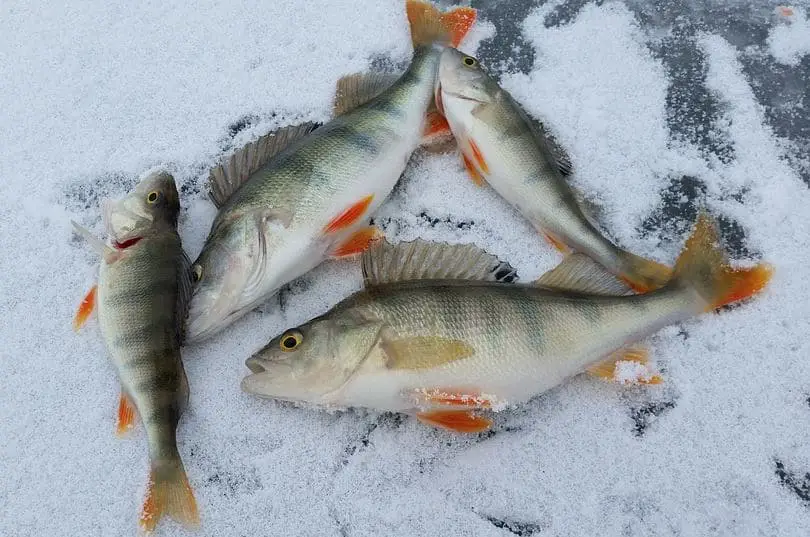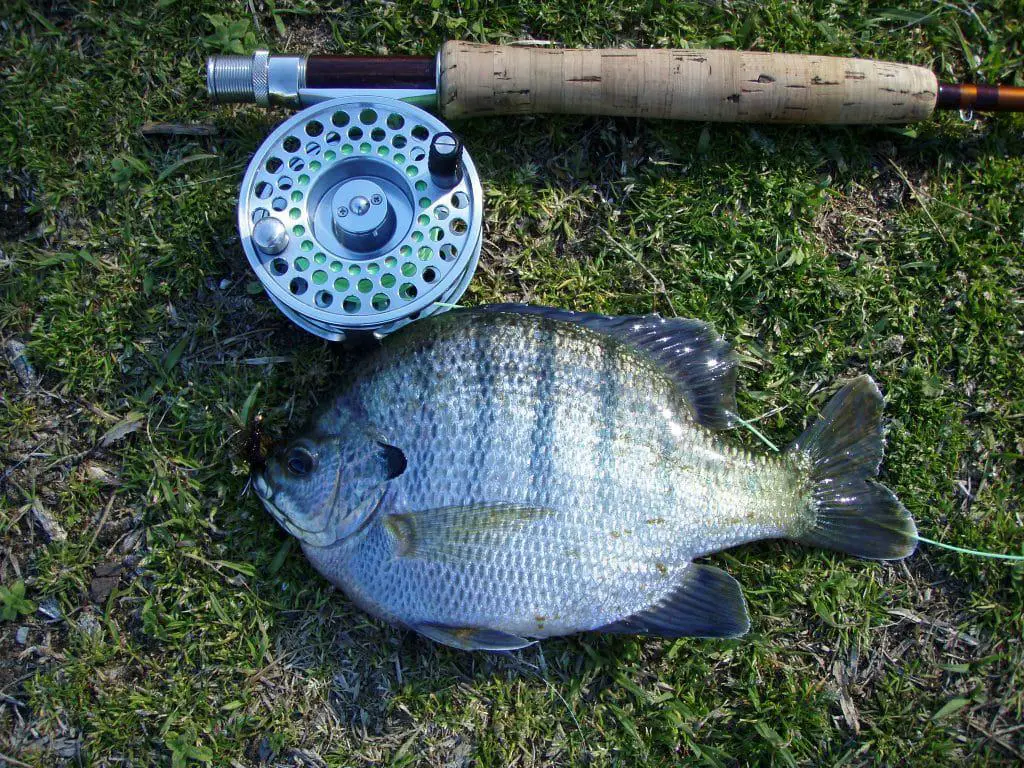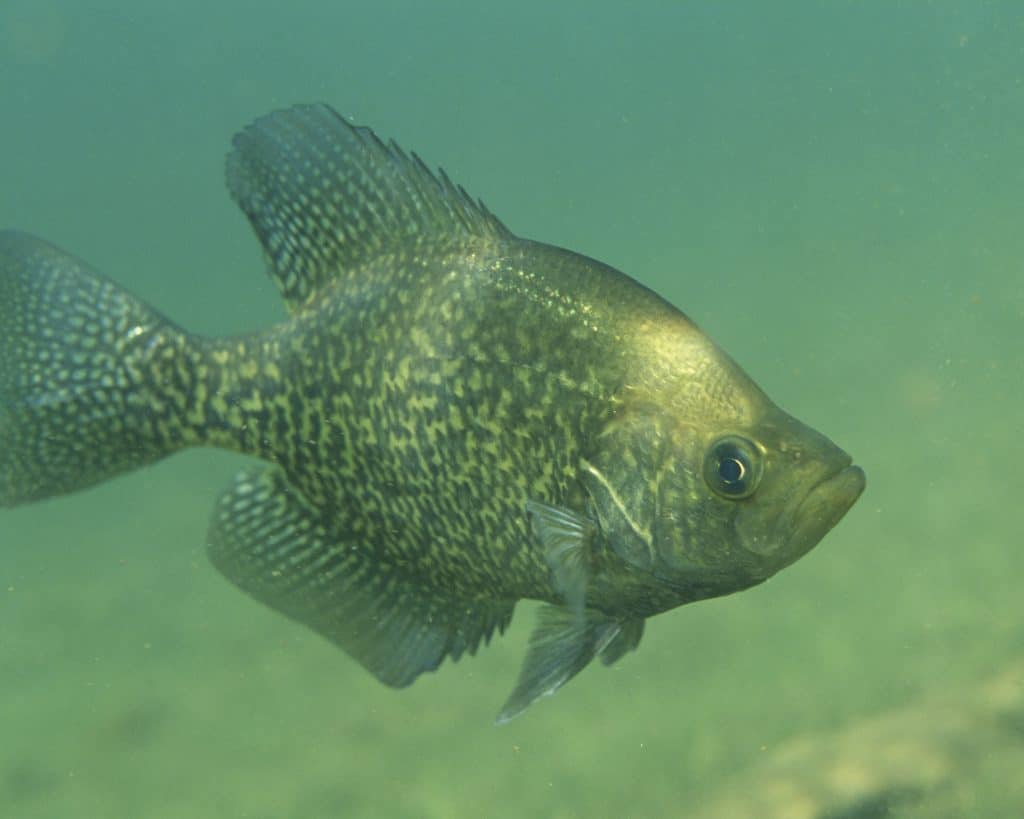
Where do panfish go in the winter? For younger anglers, this can be a baffling mystery. Getting bluegill, crappie, sunfish, and others to bite in the spring, summer, and even fall is no problem. But winter rolls around and then it takes a smart old angler to help you fill those buckets to the limit.
Some fishermen assume that once winter hits and you’re looking at very cold waters or even ice fishing, you simply have to put away the gear and wait until ice break in the spring before you can hope to bring home a big stringer of panfish that will fill up a huge cast iron frying pan.
This isn’t true at all. While catching panfish in the winter is more challenging, they can still be found in the winter.
Where panfish go in the winter depends on the exact species. Bluegills tend to go for heavily weeded areas closer to shore while perch rise up from the deep water ridges they love in the summer. We’ll deep dive further into finding & catching the most common panfish in the winter.
Table of Contents
Catching Winter Bluegill

Bluegill are absolutely delicious and there’s a reason they’re famous among the panfish. In fact, it’s not out of line to say they are probably the most popular and sought after of all the small but delicious panfish.
However, even in the best of conditions they have a reputation for taking skill to catch. And I can tell you from experience that reputation is well earned!
If you’re bait rig-up or false lure is clearly fake or there’s something amiss, you’re going to be very hard pressed to get too many bites. Bluegill are renowned for their remarkable eyesight, which is part of what makes catching them so rewarding. The hard ounce for ounce fight they bring to every hook and delicious taste they bring to the table are two others.
Catching winter bluegill can be difficult, but it’s not impossible! Whether needing to set up for ice fishing, fishing during severe cold snaps in winter months, or even hitting the water during a cold autumn, you can still catch these delicious little buggers if you know how.
The first step is understanding how their favorite habitat changes when the temperatures drop.
Where Do Bluegills Go in the Winter?
Bluegills are actually fairly predictable in the winter, especially after the first ice. The key is understanding that different parts of the day, and to an extent the weather, will actually determine where the bluegills go. By understanding how they move you’ll understand how to fish for them successfully.
In the evenings and throughout most of the day they will be in deeper water where the temperature might be cold stable. This is preferable to the shallows where many anglers commonly find them because the temperature can vary wildly there.
However there is one MAJOR exception: during the early afternoon when it gets sunny. On sunny days the shallow water can warm up considerably, making it more comfortable and drawing in the bugs and underwater larvae that bluegills feed on. So on sunny afternoons, bluegill schools go to the weedy shallows.
By understanding these habits, you’ll be able to move on from your favorite spring, summer, and autumn bluegill holes and follow these delicious panfish to get yourself in the right spots of the ice to find those hungry schools and get some successful winter bluegills.
What Do Bluegills Eat in the Winter?
There is still plenty for bluegills to snack on once the ice has settled over the water for the winter. In fact, those anglers who have had success fishing for bluegill in the winter will tell you a school of bluegill is just as hungry in winter as any other time.
Bluegills will eat a lot of different things, which makes it had to determine what the best bluegill bait is going to be in any area. The biggest thing is to think small. Bluegills like to eat insect larvae, plankton, plant bits, they are constant grazers. If you’re at a farm pond see if anyone throws food all the time like little bread bits or crackers – they might be used to that type of bait in a specific area.
For figuring out what bluegills feed on in order to catch more winter gills your best option is to have a variety of bait, live bait, and artificial lures, all small, to test around and see what they are feeding on in your area.
The number one task is finding out where the schools of bluegill are feeding under the ice. Once you get that down, it’s only a matter of time until you find something they like. From small bits of food bait to pieces of worms or even tiny artificial rubber worms, you would be surprised how much winter bluegills are willing to eat.
Catching Winter Crappie

While some anglers believe that crappie and other panfish stop eating in the winter, the truth is a much different thing. Understanding how schools of crappie move in the winter and how their patterns change during cold weather is the most important first step.
If you can figure out these things, and we’ll share how, then you’ll go from one of those anglers wondering where all the crappie have gone to one who may even believe that winter is the best time of year for great crappie fishing!
Do Crappie Bite in Cold Weather?
The short answer is yes, crappies actually feed voraciously in the winter. This is true whether you live in a cold area with no ice, or freezing areas that require ice fishing.
The key is finding where they have moved to, moving to those spots, and adjusting your fishing techniques to work better for winter panfishing versus what tends to work throughout the rest of the year.
Where Do Crappie Go in Winter?
Many fish prefer deeper water during the winter because consistent temperatures are better, even in the cold, when it comes to a fish’s comfort level. Crappie are no exception.
Crappie still like cover. If you’re ice fishing after a string of cloudy or general “gray” days then a good bet is to look for a place on the ice over a rock shelf in the lake. This meets the criteria of being deeper water and giving some cover – which means it is prime crappie territory in the winter months.
That being said, if the day has been really sunny then they are likely to take advantage of the shallows. After a few sunny days in December crappie can be found closer to shore enjoying the warmer water.
In those cases they still like to have cover close by which makes docks and weed beds particularly good places to find them. In many places going with a small vertical jig setup is the best bet for getting the crappie biting during December. Or any other winter month, for that matter.
Catching Winter Yellow Perch
Perch are an interesting study when it comes to winter fishing for panfish. This is due in part to the fact that in many places there isn’t nearly as much of a movement from autumn to winter as there is with other panfish. In other words, if you know where the big yellow perch are biting in the fall, that’s probably where you will first find them in the early winter months.
One thing to keep in mind is that perch love shad and bugs when it comes to feeding. These are going to look a bit different in winter than in the middle of summer, which is why most winter perch fishermen like using single hook ice flies or spoons.
If you like adding a bit of bait on the single hook then mayfly nymphs, waxworms, or even maggots are a good option to get more interested perch to nibble what you’re offering.
Where Do Perch Go in Winter?
However once you go to actual ice over, there is a brief time where perch tend to “scatter,” making them hard to locate during the immediate aftermath.
A few weeks after the first ice-over, things tend to settle a bit and perch will gather once again in groups. Most of the time this will be in slightly deeper water in mid-depth or deep flats.
Towards the end of winter once ice break hits then you should look at areas close to popular perch spawning sites. This includes shallow flats, very weedy bays, and shorelines full of cattails or other weedy or reedy shorelines.
During ice out when it’s still cold these are great places to find schools of perch getting ready for the spawning season.
Winter Panfishing Gear List
You want to make sure you’re prepared for whatever Mother Nature can throw at you, and she tends to be much nastier in the winter than any other month in most cases.
In addition to being prepared to enjoy a fun and safe day out on in ice, you also need to adjust your fishing gear to make sure you’re set to get the best possible results.
If you want our TL;DR shortlist of recommended ice fishing gear then here are our top choices for each item (all links go to Amazon.com) while if you want a little bit more in-depth information then scroll down past this list.
- Best temporary ice fishing shelter: Eskimo Quickfish Pop-up Portable Ice Shelter
- Best portable ice fishing heater: Mr. Heater Buddy Grey Portable RV Heater
- Best ultralight fishing rod for ice fishing: St. Croix Mojo Ice Rods
- Best telescopic fishing rod for ice fishing: KastKing Blackhawk II Telescopic Fishing Rods
- Best waterproof gloves: Glacier Glove Pro Angler Ice Fishing Gloves
- Best ice auger for winter ice fishing: ION 40V Electric 8-Inch Bit Ice Auger
- Best ice skimmer: Celsius Telescopic EVA Handle TS-3 Ice Skimmer
Best Ice Fishing Shelter
If you live in an area that always gets a very deep freeze so you have that ice fishing shack just waiting for transport then good for you! However for many of us the most practical shelter for winter fishing is going to be with a temporary ice fishing shelter.
The Eskimo Quickfish Pop-up Portable Ice Shelter is our #1 pick. There are several good options up there, but this one stands a bit above the rest. This gives you good cover from wind, offers plenty of space for that portable heater, and lets you enjoy the best that ice fishing has to offer.
If you want information you can check out our Eskimo Quickfish Ice Fishing Shelter Review.
Best Portable Ice Fishing Heater
Hey, ice fishing is great but it makes sense that you want to keep yourself as warm as possible while enjoying some winter fishing sessions. A portable heater is an absolute necessity on most days.
Not all portable heaters are equal, and this is one area where you can REALLY tell the difference between a low level fishing heater and a really high level one.
The Mr. Heater Buddy Grey Portable RV Heater is our pick for the #1 choice. This is powerful, easy to use, and safe. A great compact little heater, there’s a reason this is one of the most highly rated choices online. It’s just outstanding.
Best Ultralight Fishing Rod for Ice Fishing
One of the great benefits of ice fishing for panfish is the fact that this is a great time to break out the ultralight fishing rod. While I have had plenty of fun using an ultralight fishing rod on bigger game fish like largemouth bass or northern pike, sometimes that means a broken rod or a lot of lost lures to snapped fishing line.
But with panfish you get the hard fight on an ultralight rod without the same danger of damaging the rod. That means a lot of fun from hooking and fighting these tough little guys.
For our money the best ultralight fishing rod for ice fishing is the St. Croix Mojo Ice Rod. St. Croix is one of the top names in the business for good reason, and their reputation is backed by decades of proving it with their high quality products.
Add in the fact they focus on making fishing rods specifically for ice fishing and you can see why we’re such big fans.
Best Telescopic Fishing Rod for Ice Fishing
Some people are fine with using ultralight fishing rods when it comes to ice fishing, but there are also those who love telescopic rods. These can be a great option for control and support when it comes to ice fishing.
If you are a telescopic rod fan then we recommend another big name: KastKing. The KastKing Blackhawk II telescopic fishing rod is an excellent high-quality option that is perfect for the winter fisherman who wants just as much success on the ice as during the rest of the year.
This will give you an amazing telescopic rod that will meet all of your fishing needs.
Best Waterproof Winter Fishing Gloves
When you’re going to be fishing in really cold weather you want gloves that are not only good at keeping out the cold and keeping your fingers warm, but can also keep your fingers dry.
This is why the Glacier Glove Pro Angler Ice Fishing Gloves absolutely shine. These gloves are made of neoprene which means the gloves are 100% waterproof while also keeping the hands and fingers warm. These give the flexibility, mobility, and versatility that you need to enjoy your fishing time while sparing your poor fingers the worst that winter weather can bring.
Best Ice Auger for Ice Fishing
If you can break a hole into the ice without a good ice auger…then you should be really concerned about how solid the ice you’re standing on actually is. A good ice auger is the tool you need in order to break through the ice and set up a good ice fishing hole.
The ION 40V Electric 8-Inch Bit Ice Auger consistently makes the top of the list on anyone’s site when it comes to tools that ice anglers need. This is also our pick as the best one out there and if you can get a good deal on one, you’ll be stunned at just how well it works.
Best Ice Skimmer
The Celsius Telescopic EVA Handle TS-3 Ice Skimmer is a solid ice skimmer that will help you keep the slush and ice out of your fishing hole so your line is clear, there’s a clear path for an underwater camera, if you use one, and you are in good shape.
This is a simple piece of equipment and you might not think of it much, but try clearing out the fishing hole with your hands. Not a happy time.
Other Ice Fishing Gear
There are plenty of different types of fishing gear you need, especially when it comes to ice fishing in the winter. It can be easy to forget some piece of gear when you’re excited or focused on other things, like that stringer of big bluegill, croppie, or perch that you’re going to be catching and then frying up later.
That said, the following five links are to some of our best fishing gear review blog posts about gear we haven’t talked about yet in this post.
- Best fillet knives reviewed
- Best electric fillet knives reviewed
- Best fishing hook sharpeners
- Best ice auger replacement blades
- Best balaclavas for winter
This article should have answered all the questions you have on panfishing in winter. Whether you’re looking for winter bluegill, winter perch, or winter crappie, or even just looking for new winter fishing gear, we have given you the information, recommendations, and resources needed for you to have your best winter fishing results yet!
You Might Also Like to Read:
- What Is a Panfish?
- Do Lake Trout Feed at Night?
- Wet Fly vs. Dry Fly
- Are Walleye Really a Perch?
- Best Walleye Fishing Nets
In Conclusion
No denying that winter fishing for bluegills, perch, sunfish, and crappie can provide a bit of a challenge but catching them in winter is doable. It is also very much worth it, as anyone who has ever stood over a hot oil fryer or even frying pan of oil can attest.
Freshly fried panfish is a true culinary treat, and I know I’m speaking a fact when I say my brother and I are always up for another pan. If the hunger hits you in the middle of winter, the good news is that contrary to popular opinion, it’s not impossible to catch panfish in the winter.
The key is to understand how they move when the water gets cold, adjust your fishing hole strategies accordingly, and take some time to find those moving schools. Even in the middle of winter under the ice it is only a matter of time until they hit a feeding frenzy.
